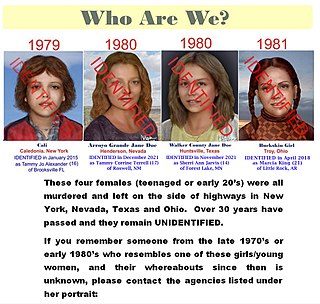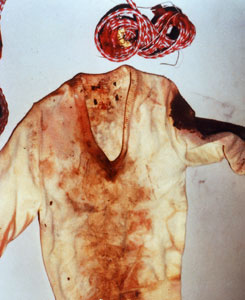Related Research Articles

The Cleveland Torso Murderer, also known as the Mad Butcher of Kingsbury Run, was an unidentified serial killer who was active in Cleveland, Ohio, United States, in the 1930s. The killings were characterized by the dismemberment of thirteen known victims and the disposal of their remains in the impoverished neighborhood of Kingsbury Run. Most victims came from an area east of Kingsbury Run called "The Roaring Third" or "Hobo Jungle", known for its bars, gambling dens, brothels and vagrants. Despite an investigation of the murders, which at one time was led by famed lawman Eliot Ness, the murderer was never apprehended.

FamilyTreeDNA is a division of Gene by Gene, a commercial genetic testing company based in Houston, Texas. FamilyTreeDNA offers analysis of autosomal DNA, Y-DNA, and mitochondrial DNA to individuals for genealogical purpose. With a database of more than two million records, it is the most popular company worldwide for Y-DNA and mitochondrial DNA, and the fourth most popular for autosomal DNA. In Europe, it is the most common also for autosomal DNA. FamilyTreeDNA as a division of Gene by Gene were acquired by MYDNA, Inc., an Australian company, in January 2021.
Colleen M. Fitzpatrick is an American forensic scientist, genealogist and entrepreneur. She helped identify remains found in the crash site of Northwest Flight 4422, that crashed in Alaska in 1948, and co-founded the DNA Doe Project which identifies previously unidentified bodies and runs Identifinders International, an investigative genetic genealogy consulting firm which helps identify victims and perpetrators of violent crimes.

The Gilgo Beach serial killings were a series of killings between 1996 and 2011 in which the remains of 11 people were found in Gilgo Beach, located on the South Shore of Long Island, New York, United States. Most of the known victims were sex workers who advertised on Craigslist. The perpetrator in the case is known as the Long Island Serial Killer. One of the victims was a female toddler.

Dawn Olanick, previously known as Princess Doe, was an unidentified American teenage decedent from Bohemia, New York, who was found murdered in Cedar Ridge Cemetery in Blairstown Township, New Jersey on July 15, 1982. Her face had been bludgeoned beyond recognition. She was the first unidentified decedent to be entered in the National Crime Information Center. Olanick was publicly identified on the 40th anniversary of her discovery.

The Bear Brook murders are female American murder victims, two discovered in 1985 and two in 2000, at Bear Brook State Park in Allenstown, New Hampshire, United States. All four of the victims were either partially or completely skeletonized; they were believed to have died between 1977 and 1981.

Sherri Ann Jarvis was an American murder victim from Forest Lake, Minnesota whose body was discovered in Huntsville, Texas on November 1, 1980. Her body was discovered within hours of her sexual assault and murder, and remained unidentified for 41 years before investigators announced her identification via forensic genealogy in November 2021.

Dana Lynn Dodd was a formerly unidentified American murder victim whose body was found in 2006 in Kilgore, Texas. In 2013, investigators had hoped that a new reconstruction of the victim might uncover more leads. In August 2018, Joseph Wayne Burnette was indicted for her murder, following a confession, stating her name may have been "Ashley." The victim's case was later submitted to the DNA Doe Project, who made an identification in January 2019, 12 years later. While she remained unidentified, she was known by the nickname "Lavender Doe".

Unidentified decedent, or unidentified person, is a corpse of a person whose identity cannot be established by police and medical examiners. In many cases, it is several years before the identities of some UIDs are found, while in some cases, they are never identified. A UID may remain unidentified due to lack of evidence as well as absence of personal identification such as a driver's license. Where the remains have deteriorated or been mutilated to the point that the body is not easily recognized, a UID's face may be reconstructed to show what they had looked like before death. UIDs are often referred to by the placeholder names "John Doe" or "Jane Doe". In a database maintained by the Ontario Provincial Police, 371 unidentified decedents were found between 1964 and 2015.

The St. Louis Jane Doe is an unidentified girl who was found murdered in the basement of an abandoned apartment building on February 28, 1983 in St. Louis, Missouri. She has also been nicknamed "Hope", "Precious Hope", and the "Little Jane Doe." The victim was estimated to be between eight and eleven when she was murdered and is believed to have been killed via strangulation. She was raped and decapitated. The brutality of the crime has led to national attention.

CeCe Moore is an American genetic genealogist who has been described as the country's foremost such entrepreneur. She has appeared on many TV shows and worked as a genetic genealogy researcher for others such as Finding Your Roots. She has reportedly helped law enforcement agencies in identifying suspects in over 300 cold cases using DNA and genetic genealogy. In May 2020, she began appearing in a prime time ABC television series called The Genetic Detective in which each episode recounts a cold case she helped solve. In addition to her television work, she is known for pioneering the genetic genealogy methodologies used by adoptees and others of unknown origin for identifying biological family.

Deanna Lee Criswell was an American girl from Washington state who was murdered by firearm at age 16 and remained unidentified for 27 years. Criswell's body was found on November 25, 1987 in Marana, Arizona, near Tucson. The Marana Police Department announced her identification on February 11, 2015, aided by the sophisticated technology of forensic facial reconstruction and DNA analysis, and by websites set up by amateurs to help identify missing and unidentified persons.

Terry Peder Rasmussen was an American convicted murderer and suspected serial killer who was convicted of one murder, and linked to at least five more in a series of crimes that stretched across the contiguous United States between 1978 and 2002. Due to his use of many aliases, most notably "Bob Evans", Rasmussen is known as the Chameleon Killer.
Parabon NanoLabs, Inc. is a company based in Reston, Virginia, that develops nanopharmaceuticals and provides DNA phenotyping services for law enforcement organizations.

GEDmatch is an online service to compare autosomal DNA data files from different testing companies. It is owned by Qiagen.

DNA Doe Project is an American nonprofit volunteer organization formed to identify unidentified deceased persons using forensic genealogy. Volunteers identify victims of automobile accidents, homicide, and unusual circumstances and persons who committed suicide under an alias. The group was founded in 2017 by Colleen M. Fitzpatrick and Margaret Press.
Othram is an American corporation specializing in forensic genetic genealogy to resolve unsolved murders, disappearances, and identification of unidentified decedents or murder victims. The company also offers law enforcement agencies tools and programs to infer kinship among individuals, both closely and distantly related, through a combination of short tandem repeat and single nucleotide polymorphism testing, as well as forensic genome sequencing of DNA.

Elizabeth "Lisa" Ann Roberts, otherwise known as Precious Jane Doe, was an American homicide victim found near Everett, Washington on August 14, 1977, who was an unidentified decedent for 43 years until being identified on June 16, 2020. She had been picked up by a male driver while hitchhiking and killed after refusing sex. Her assailant had strangled her with a cord and then emptied his gun into her head, complicating identification. Roberts was a teen runaway who left her Oregon home in July 1977, less than a month before her murder. She was given the nickname "Precious Jane Doe" by Detective Jim Scharf, who began investigating the case in 2008. The detective was quoted as saying, "This young girl was precious to me because her moral decision from her proper upbringing cost her her life [...] I knew she had to be precious to her family too, so I had to find them. We needed to give her name back to her and return her remains to her family." Roberts was 17 at the time of her murder, though initial police estimations of her age were much older. Her body was found by blackberry pickers, and the medical examiner determined she had been dead for approximately 5 days before discovery. She was discovered fully clothed in a pastel tank top and denim cutoffs. As her identity remained unknown, Roberts' case was relegated as a cold case. In 2020, genetic testing via hair samples was used to locate her biological family, who led to her adoptive family.

Ruth Belle Waymire, formerly known as Millie Doe, was a formerly unidentified female murder victim whose dismembered body was found in Spokane, Washington in 1984. Her body was recovered from the Spokane River on June 20, 1984, and was missing the hands, feet, and head. 14 years later, in 1998, a skull was found elsewhere in Spokane that was later determined as belonging to Waymire. While transporting the skull for forensic analysis, the detective responsible for the case was accompanied by his young daughter, who said "Since we have another person in the room, we should name her. Let's call her Millie". She was identified on March 29, 2023 by Othram.
The Great Basin Murders is the name given to a series of murders of at least nine women committed between 1983 and 1997 across the states of Wyoming, Utah, Nevada, and Idaho. It derives its name from the Great Basin geographical area, as most of the victims had their bodies dumped near interstate highways that transverse it.
References
- ↑ "Buffalo Cave remains identified as Joseph Henry Loveless - Crime & Courts".
- ↑ "Headless torso found in Idaho cave identified as outlaw who escaped jail in 1916". CBS News. January 1, 2020. Retrieved January 10, 2020.
- 1 2 3 Griffith, Janelle (December 31, 2019). "Human remains found in Idaho cave identified as outlaw who died over 100 years ago". NBC News. Retrieved January 3, 2020.
- 1 2 3 4 5 "Headless Torso Found in Idaho Cave Identified as Bootlegger". The New York Times. Associated Press. December 31, 2019. Retrieved January 3, 2020.
- 1 2 3 Murphy, Heather (January 3, 2020). "Human Remains in a Cave Identified as a Bootlegger Who Escaped Jail". The New York Times. Retrieved January 3, 2020.
- ↑ "103-year-old murder case cracked after headless torso found in Idaho cave". St. Lucia News Online. New York Post. January 2, 2020. Archived from the original on February 23, 2020. Retrieved February 23, 2020.